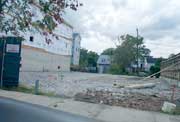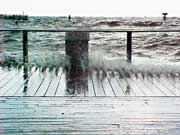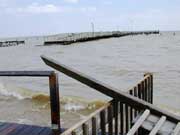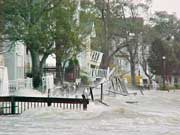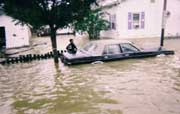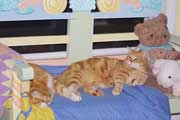 |
|||||||||||||||||
|
Volume 12, Issue 38 ~ September 16-22, 2004
|
|||||||||||||||||
|
Looking through my old journals the other day, I came upon what I’d been writing the week before the flood. I had tried to express how beautiful the evening Bay was from my front porch. “A silvery blue, cool frosted satin. Apricot tints. One huge cloud piled high, mound after expanding mound of rich creamy froth, the sun glowing behind it outlining the edges.” Reading, I was hit with panic. I had a brief cartoon-like vision: the coyote standing smiling, back to the tunnel as the train comes barreling toward him. I wanted to yell at the me sitting there with my cocktail “It’s coming! Can you hear me? It’s coming!” But what good would it have done to know? I could have saved my computer, my stereo, my video camera. But I couldn’t have done anything about the most important losses: of home, of neighbors, of a way of life. Denial After distributing the cookies that day and speculating with everyone about how bad it was going to be, I went home to do precautionary things. A neighbor helped me tape windows, and I carried lightweight things upstairs or put them up high, like my video camera on the refrigerator. Most of my efforts were half-hearted. I never imagined it would be any worse than Floyd had been years ago, when the yard flooded and some folks got an inch or two of water in their living rooms. As the day wore on so many conflicting reports flew back and forth. The storm had lessened, was “just” a tropical storm; no, it was severe. As a psychologist, I might have remembered that denial can cause a person to do silly things. What I did before Isabel was sit tight. I didn’t want to pack up my three cats and impose them on friends, and I was not willing to leave them. As a compromise, I took my car up the hill, like my neighbors did, so that if we got water in the street it would be safe. But then I was more nervous, because if we got more than a few inches in the street and I wanted to leave, there would be no way I could carry three cats. This was the first of many such decisions.
I won’t rehash the whole evening and that night. But I remember, just as I remember the countless things that my neighbors did to help me. Some called regularly to see if I was okay. One offered to leave his Jeep so I’d have a way to get out if I wanted. A couple up the hill gave me the keys to their house when they left. Toward the end, everything happened fast. I had decided, finally, to stay and was eating a late dinner of St. André cheese, pepper-stuffed olives and pâtè. The electricity was out, the phones were out. I could no longer see how high the water was. I was scared, so I had called a friend on my cell phone when I saw on the alternate line that one of my neighbors was calling. I picked up to hear my neighbor say he was taking his wife and kids out the back way; the water had gotten so high he was fearful. He said he’d come back for me if I wanted to go. Panic washed through me, along with gratitude. But I didn’t want to endanger anyone because I’d been silly enough to stay. My other friend called back, and when I told her what was happening, she said, “I don’t care what you think. I’m calling 911.”
Minutes later a big truck was honking outside my door. In its headlights I could see waves crashing over the seawall and water hip deep in the road. Again panic surged. I grabbed my cat Tiger and shoved him in his carrier again and again, for he kept shoving his head up as I tried to zip him in. Finally, the horn honking again, I shoved him down hard and got the carrier zipped. I ran for the door, shutting my other two cats upstairs. I waded to where the North Beach truck waited for me and managed to climb in. As beach patrolman Brian McNeil turned the truck around, waves washing all around us, I felt so stupid and guilty to be the cause of his having to rescue me. I apologized over and over as he brushed aside my thanks. He dropped me off at my car, at which time I realized I had left my purse, glasses and car keys behind. Thank God I had an extra set of keys on me. I drove in pouring rain and screaming wind with Tiger plaintively meowing all the way to my friend Kathleen’s house in Chesapeake Beach. The rest of the night is a blur, filled with fear and darkness and the sound of crashing trees. Reconnaissance Kathleen and I went out at sunrise to try to get back to my house and my other two cats. I still have nightmares of the visions of Atlantic Avenue from up the hill on Seventh Street where we parked. Huge waves were rolling in and crashing onto the street. The water was chest deep at the intersection of Seventh Street and Annapolis Avenue. As I sobbed at the thought of what my cats were experiencing, Kathleen took my hand and we waded into the water. I was shaking so hard I could barely walk, but hand in hand we kept going. A picture of us later appeared in USA Today, and I can tell you it is not how I would have chosen to look for my 15 seconds of fame. My hand in Kathleen’s, her moving me forward, is such a metaphor for that period. I am an independent woman who does not like to ask things of others, but for days I felt like I was passed from supportive hand to supportive hand as my friends stepped in to help me. It was one of the true blessings in the whole experience. As Kathleen and I came from the backyard of my neighbor four houses down onto Atlantic Avenue, I could see we would not make it to my house. The waves were too big there and the undertow dangerous. Drenched, filthy and horrified, I went back to Kathleen’s to wait for low tide.
The water was only knee deep when we returned. But this time I could see the devastation. One bizarre scene stays frozen in my mind. The entire front of my neighbor’s house was ripped off. It made me think of my childhood Barbie house, where you could look in the front and see all the little furniture. Fortunately my neighbors were not there, playing Barbie and Ken. The sight of my home, twisted and shattered, covered with mud and speckled with holes, broke my heart. The shock stopped me in my tracks while Kathleen ran up the stairs to check on my cats. “Oh my God! Oh my God! Oh, my God!” I repeated over and over. My poor, dear little house. I was snapped out of my daze by a meow from upstairs, and I ran to see my boys. Freaked out but okay, they provided me with the only comedy I remember in those first few days. I had brought a box to carry the cats, but after Big jackhammered his head and paw through the crack at the top for the fourth time, I gave up trying to get him in. I gave up on rescuing Little that day after no amount of tugging and pulling would get him un-Velcroed from the carpet. I left him food, wrapped Big in a towel, grabbed my purse, glasses, camera and left. Big didn’t move a muscle as we waded out. The only dicey moment came when the town truck headed toward us on a side street. Kathleen saw the look of terror in Big’s eyes and his flexing to jump, and she leaped out into the road screaming “Stop!” If there was a good moment that day, it was that. The truck stopped, and I got Big back to my car.
The following weeks passed in a hyper-charged adrenaline mode: trying to get my things out of the house, filing insurance claims, looking for a rental house. I had never in my life been without a home, and it was discombobulating. Even during the worst, however, I felt lucky. I was touched and humbled by friends’ support. I wasn’t sure I would have been so wonderful, so accommodating, which was a lesson in itself for me.
As much valued as actions were also the words and emotional support from so many friends. My friend Tania looked me in the eye the first time she saw me after the flood and said, “I know in my heart that this will lead you somewhere new where you need to be.” It really helped me to believe those words. I still get weekly pep-talks from her, along with my chiropractic adjustments. The generosity went on and on. I couldn’t feel all sad with so much love. Trite as it sounds, it is absolutely true that disasters, tragedies, hard times bring out the best and the worst in people.
My worst was spelled I-N-S-U-R-A-N-C-E. I was driven every moment of every day for the first two weeks by two primary goals: finding somewhere new to live and getting an adjuster to come assess the damage to my old home. Both were equally frustrating. It was obvious to me that my home would never be habitable again, as it had been knocked from its foundation. Wave action had torn big holes in the walls, and the porch had been ripped off and dropped in the back yard. The surviving structure was full of mud and muck. But already I was hearing horror stories of people whose adjusters had showed up only to offer them ridiculously low sums to repair the damage. I remember the evening after I had achieved my two goals of finding a house and getting an appointment with my adjuster. After looking all day at houses I could never picture being at home in, I was down to one house on the agent’s list. I was near tears and exhausted, and I hadn’t eaten since a morning scone at Susan’s. But this listing said something about 60 acres of farm, and a bit of hope stirred within me. Peace. Land. A place to recover. When we drove up around the bend at the top of the long, winding dirt drive and saw the rambling old yellow farmhouse, I breathed a sigh of relief. Room for me and the kitties to roam. That evening, glass of wine in hand, I felt less panic than I had in days. Things were feeling a little less intense, a bit less scary. I was telling the cats about their new house — Susan wasn’t home yet — when I noticed movement on the patio. I looked out to see three peahens, gray forms in the dim gray dusk light. In a surreal moment, I flashed back on a dream two weeks before the flood. In the dream, I watch a bird walking back and forth in the same gray dusk. I think it is a peacock, but, no, it is gray. I focused on the sprouts that come out the top of the head and thought, oh, no, its not a peacock, it’s a phoenix. And up it goes in flames. Hey, this is my first glass of wine! I said to myself. But I wasn’t dreaming again or hallucinating. Susan’s neighbor really did have peacocks. Looking for meaning in all the chaos, I thought about what the phoenix symbolizes: Death and rebirth. Endings and beginnings. Coming out of the ashes stronger and wiser. I thanked whatever gods had sent me this hopeful image and drank another glass of wine.
As I sit in the August heat almost a year later, looking out over acres and acres of green instead of my old water view, I have not yet achieved the rebirth of a new home. I’m still searching for a place that will make me feel like I did when I walked into my old house in North Beach. I chose not to go back for many reasons, the main ones being intangible. It didn’t feel right. I’m looking on the Eastern Shore. Chestertown is lovely. But I have yet to feel that I have found a home. Along the way there have been smaller deaths and rebirths, losses and gifts. I’ve lost touch with some of my old neighbors, some scattered in all directions, some still there. It’s hard to pass down my old street since my house was demolished earlier this summer. I lost my patience (and I never had much to start with) and threatened to sue when the insurance payment was delayed. I lost cherished photographs stored in downstairs closets, and I lost Little the cat, who took off the first day at the farmhouse. I lost a neighborhood that will never exist again. We were a neighborhood of little old houses, from green to purple, and a few big new houses and people who’d lived there forever and people who’d just moved in. I know the street will be special in a new way, but it won’t ever again be that same street I lived on the morning of September 18, 2003. What’s new in me is a sense of my own strength. I can handle things I never imagined I could. I’m learning how to receive with open heart and open hands and to appreciate that I am loved. As I drove home this week from a meeting with the people who are buying my lot, I felt an immense sadness. They were so happy with all their plans for their new home and their new life, and I was happy for them. They’re great people to be part of the new neighborhood. I caught myself wishing I’d already found my new home, so I didn’t have to let go of the old without having the new. But then I thought again of the phoenix. It’s only when the ashes settle that a new one arises. Learning to live with the gaps, the empty spots, without rushing in to fill them, is one of the hardest things in life. But this whole process has taught me about doing what you can and then letting go, kind of like the A.A. prayer. So I look at all the real estate listings and read the classifieds and go for drives. But I don’t let a spectacular sunset over the field of green or the wren’s achingly lovely song across the field go by without appreciating that I am alive and well — and that life in all its incredible beauty goes on.
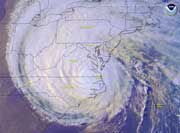 Isabel in Our Midst Isabel in Our MidstOn September 6, 2003, a disturbance east of the Leeward Islands in the Caribbean was upgraded to a tropical storm. As all storms, once it was upgraded it received a name: Isabel. Little did residents along Chesapeake Bay realize that the name Isabel would become synonymous with floods, toppled trees, power outages, legislative scuffles, insurance claims and drawn-out fights with FEMA. Isabel was upgraded to a Category Five hurricane with 160mph winds on September 11. By September 16, Gov. Robert Ehrlich had declared a state of emergency, effectively shutting down Maryland in preparation of the storm. On the afternoon of September 18 Isabel, with winds still hovering around 100mph, crossed into Maryland. What made Isabel so damaging was the devastating tidal flooding, which reached 7.58 feet in Annapolis. The tidal surge was largely responsible for the destruction of 500 homes in Maryland alone, with heavy damage to nearly 3,600 others. In Anne Arundel County, Isabel destroyed 72 homes and did major damage to another 595. Calvert County endured winds exceeding 75mph with storm surges of six feet or more, flooding and hammering beach communities like Breezy Point, Cove Point and North Beach. About two million Marylanders were left in the dark; even with workers rushing from out of state, power was not restored for more than a week. In Anne Arundel County storm costs have since risen to $3,713,700.88. Calvert faired better with $818,000 for county costs plus another $688,000 for Breezy Point, a self-sustaining community. In all, by the time the U.S. government listed Maryland a federal disaster site on September 19, the cost of Isabel was estimated in excess of one billion dollars. As the Chesapeake region marks the first anniversary of Isabel, small disturbances on the radar are no longer just blips but threats to a way of life that can be swept away with the tide. —Louis Llovio |
|||||||||||||||||
|
© COPYRIGHT 2004 by New Bay Enterprises, Inc. All rights reserved. |

 In Isabel’s Wake A Memoir of Loss, Pain and Gain
In Isabel’s Wake A Memoir of Loss, Pain and Gain

